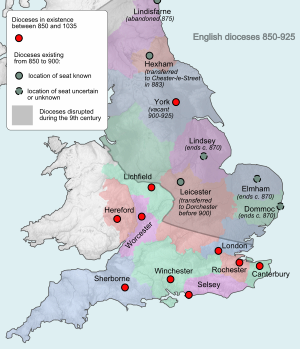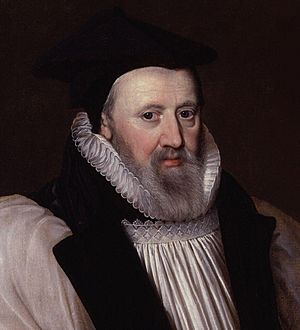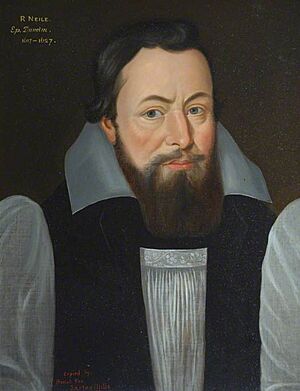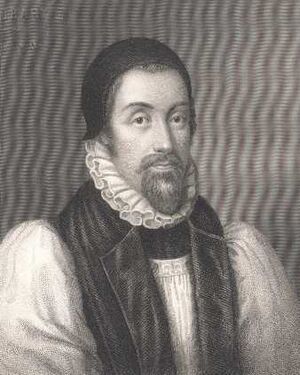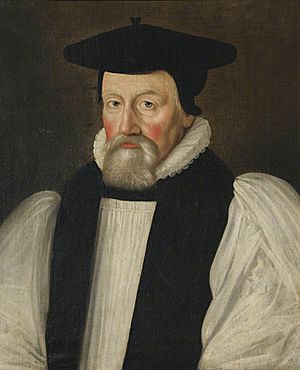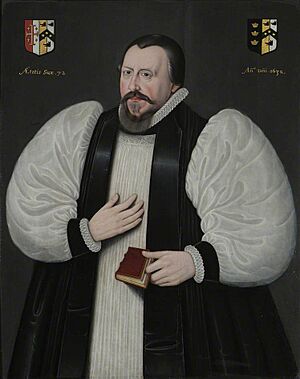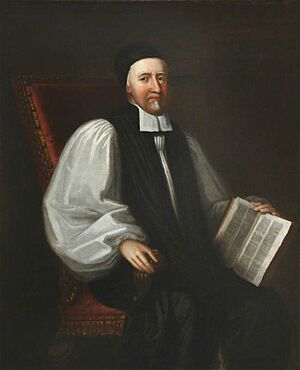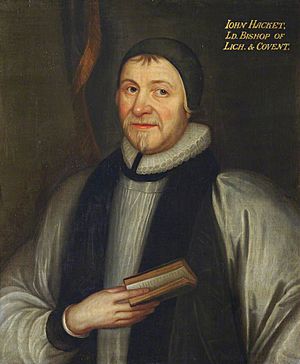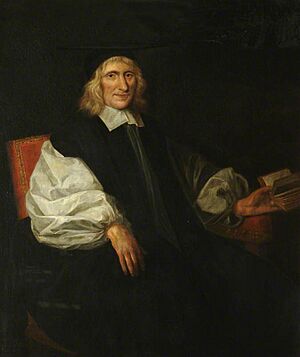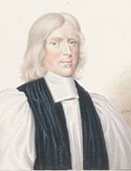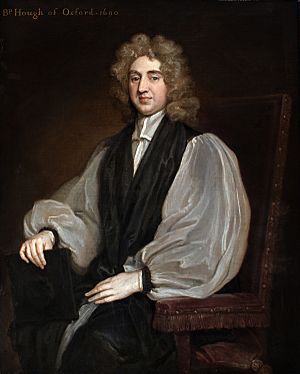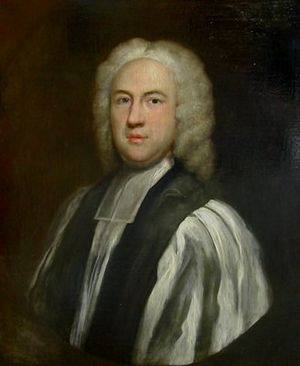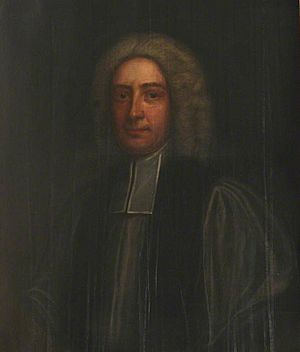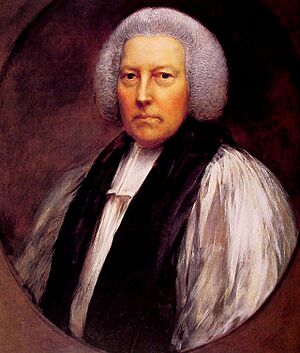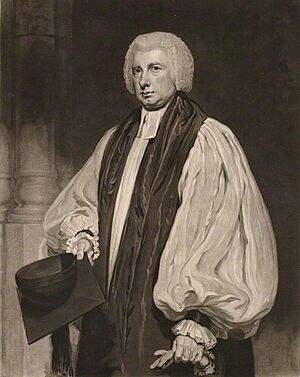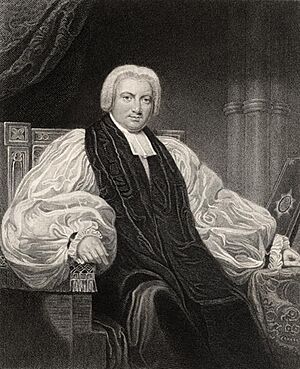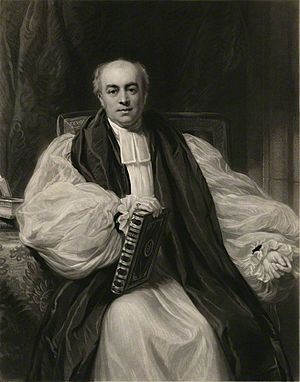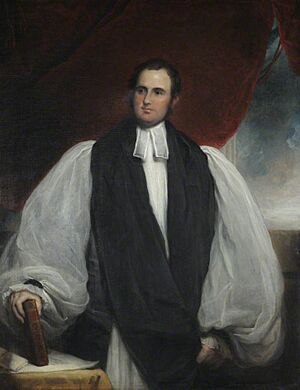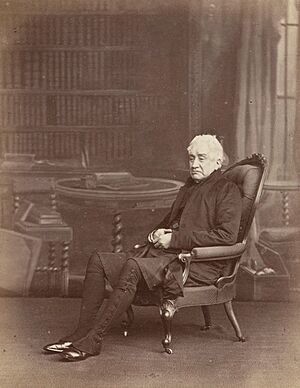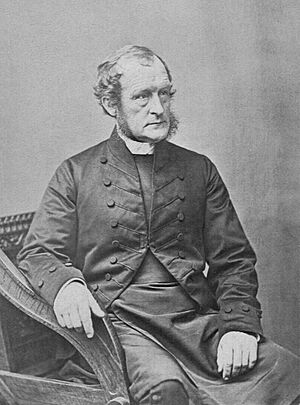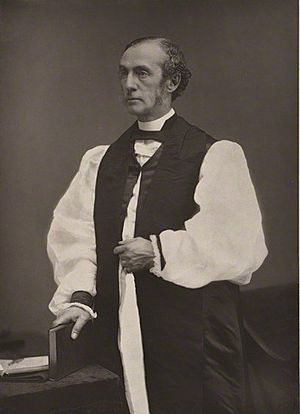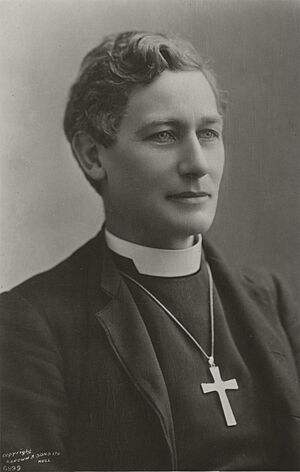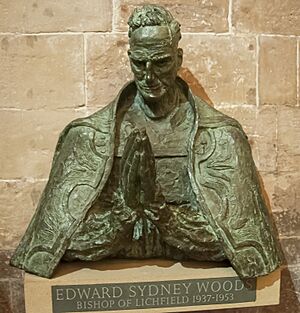Bishop of Lichfield facts for kids
Quick facts for kids {{{name}}} |
|
|---|---|
| Location | |
| Ecclesiastical province | Canterbury |
| Information | |
| Established | 7th century AD |
| Cathedral | Lichfield Cathedral |
The Bishop of Lichfield is an important leader in the Church of England. They are in charge of the Diocese of Lichfield, which is like a special area or region. This diocese covers parts of Powys, Staffordshire, Shropshire, Warwickshire, and the West Midlands.
The Bishop's main church, called a cathedral, is the Cathedral Church of the Blessed Virgin Mary and Saint Chad in the city of Lichfield. The Bishop lives at the Bishop's House, Lichfield, which is near the cathedral. The current Bishop is Michael Ipgrave. He became Bishop on 10 June 2016.
Contents
A Look Back: The History of Lichfield Bishops
The story of the Lichfield bishops began a long time ago, in the year 656. Back then, the area was known as Mercia, and Diuma was its first Bishop.
Later, in 669, a leader named Chad became Bishop. His main church was in Lichfield, so the area became known as the Diocese of Lichfield. In 691, this large area was split into smaller dioceses. These included Lichfield, Leicester, Lindsey, Worcester, and Hereford.
A Brief Time as an Archbishopric
For a short time, from 787 to 799, Lichfield was home to an archbishop. This happened during the time of Offa, who was a powerful King of Mercia. King Offa wanted his own church leader to be as important as the Archbishop of Canterbury. The Archbishop of Canterbury was in Kent, which was not part of Offa's kingdom.
So, King Offa, with permission from Pope Adrian I, created a new archbishopric in Lichfield. This meant that the Archbishop of Lichfield, Hygeberht, was in charge of many bishops from the Humber River down to the Thames. However, this special arrangement only lasted for 16 years. After King Offa died, the title of Archbishop was given back to the Archbishop of Canterbury.
Moving the Bishop's Seat
Over the centuries, the main location for the Bishop changed a few times.
- In 1075, the Bishop's seat moved to Chester.
- By 1102, it moved again to Coventry.
- From 1228, the official title became Bishop of Coventry and Lichfield. This meant the Bishop had important churches in both cities.
After the English Reformation in the 1530s, the church in Coventry was taken down. Then, after King Charles II returned to power in 1660, the Bishop was called Bishop of Lichfield and Coventry.
Finally, in 1837, the old bishopric was divided. The area around Coventry became part of the see of Worcester. From then on, the leader has been known simply as the Bishop of Lichfield.
Who Were the Bishops?
Many important people have served as Bishop of Lichfield (or its earlier names) over the centuries. This table shows some of them, from the very first bishops of Mercia to the current Bishop of Lichfield.
| Bishop of the Mercians | |||
|---|---|---|---|
| From | Until | Incumbent | Notes |
| ? | aft 655 | Diuma | The first Bishop of Mercia. |
| dates unclear | Ceollach | Resigned and went back to Scotland. | |
| c658 | c 662 | Trumhere | Abbot of Ingethling. |
| c 662 | c 667 | Jaruman | |
| Bishop of the Mercians and Lindsey people (based at Lichfield) | |||
| 669 | 672 | Chad | Saint Chad. His main church was in Lichfield. |
| Bishops of Lichfield | |||
| 672 | c674 | Winfrith | The first bishop specifically of Lichfield. |
| c 676 | bef 692 | Seaxwulf | Also known as Saint Sexwulf. |
| 691 | bet 716–727 | Headda | |
| bef 731 | 737 | Aldwine | |
| 737 | bet 749–767 | Witta | |
| bef 757 | 765 | Hemele | |
| c 765 | c 769 | Cuthfrith | Died while in office. |
| c 769 | bet 777–779 | Berhthun | Died while in office. |
| 779 | 787 | Hygeberht | Became the Archbishop of Lichfield in 787. |
| Archbishop of Lichfield | |||
| 787 | 799 | Hygeberht | The only Archbishop of Lichfield. |
| Bishops of Lichfield | |||
| From | Until | Incumbent | Notes |
| bet 799–801 | bet 814–816 | Ealdwulf | The title of Archbishop was no longer used. |
| bet 814–816 | bet 817–818 | Herewine | |
| 818 | 830 | Æthelwold | |
| 830 | bet 830–836 | Hunberght | |
| bet 830–836 | bet 841–845 | Cynefrith | Also known as Saint Cumbert. |
| bet 843–845 | bet 857–862 | Tunberht | |
| bet 857–862 | bet 866–869 | Wulfsige | |
| bet 866–869 | bet 875–883 | Eadberht | |
| bet 875–883 | bet 889–900 | Wulfred | |
| bet 889–900 | bet 909–915 | Wilferth | |
| bet 903–915 | bet 935–941 | Ælfwine | |
| bet 935–941 | bet 946–949 | Wulfgar | |
| bet 946–949 | bet 963–964 | Cynesige | |
| bet 963–964 | 975 | Wynsige | |
| 975 | bet 1002–1004 | Elphege | |
| bet 1002–1004 | after 1017 | Godwin | |
| after 1017 | bet 1026–1027 | Leofgar | |
| c 1027 | 1039 | Brihtmær | |
| 1039 | 1053 | Wulfsige | |
| 1053 | 1067 | Leofwin | Abbot of Coventry. |
| 1067 | 1075 | Peter | Moved the main church to Chester. |
| Bishops of Chester | |||
| 1075 | 1085 | Peter | |
| 1086 | 1102 | Robert de Limesey | Moved the main church to Coventry. |
| Bishops of Coventry | |||
| From | Until | Incumbent | Notes |
| 1102 | 1117 | Robert de Limesey | Died while in office. |
| 1117 | 1121 | No bishop for 4 years | |
| 1121 | 1126 | Robert Peche | Died while in office. |
| 1126 | 1129 | No bishop for 2 years | |
| 1129 | 1148 | Roger de Clinton, Bishop of Lichfield and Coventry | The title started to include both cities. |
| 1149 | 1159 | Walter Durdent | |
| 1161 | 1182 | Richard Peche | |
| 1183 | 1184 | Gerard la Pucelle | |
| 1184 | 1188 | No bishop | |
| 1188 | 1198 | Hugh Nonant | |
| 1198 | 1208 | Geoffrey de Muschamp | |
| 1208 | 1215 | No bishop due to a church ban by Pope Innocent III. | |
| 1215 | 1223 | William de Cornhill | |
| 1224 | 1228 | Alexander de Stavenby | Became Bishop of Coventry and Lichfield. |
| Bishops of Coventry and Lichfield | |||
| From | Until | Incumbent | Notes |
| 1228 | 1238 | Alexander de Stavenby | The first official Bishop of Coventry and Lichfield. |
| 1239 | William de Raley | Elected but chose to be Bishop of Norwich instead. | |
| 1239 | Nicholas Farnham | Elected but did not take the job. | |
| 1239 | William de Manchester | Elected but did not take the job. | |
| 1239 | December 1241 | Hugh de Pateshull | Became Bishop after some disagreement. |
| December 1241 | 8 December 1241 | Richard le Gras | Elected but died or declined. |
| December 1241 | 1245 | No bishop | |
| 1243 | Robert de Monte Pessulano | Elected but refused the job. | |
| 1245 | 1256 | Roger Weseham | Appointed by the Pope. |
| 1258 | 1295 | Roger de Meyland | |
| 1296 | 1321 | Walter Langton | Also served as Lord Treasurer. |
| 1322 | 1358 | Roger Northburgh | Also served as Lord Treasurer. |
| 1360 | 1385 | Robert de Stretton | |
| 1386 | 1386 | Walter Skirlaw | Moved to another bishopric. |
| 1386 | 1398 | Richard le Scrope | Moved to be Archbishop of York. |
| 1398 | 1414 | John Burghill | |
| 1415 | 1419 | John Catterick | Moved to another bishopric. |
| 1419 | 1419 | James Cary | Died before taking another job. |
| 20 November 1420 | 13 March 1447 | William Heyworth | |
| 1447 | 1452 | William Booth | Moved to be Archbishop of York. |
| 1452 | Nicholas Close | Chancellor of Cambridge University. | |
| 1453 | 1459 | Reginald Boulers | |
| 1459 | 1490 | John Hales | |
| 1493 | 1496 | William Smyth | Moved to another bishopric. |
| 1496 | 1502 | John Arundel | Moved to another bishopric. |
| 1503 | 1531 | Geoffrey Blythe | |
| 1534 | 1539 | Rowland Lee | His title changed when Coventry Cathedral was closed. |
| Bishops of Lichfield and Coventry | |||
| From | Until | Incumbent | Notes |
| 1539 | 1543 | Rowland Lee | Continued as Bishop with the new title. |
| 1543 | 1554 | Richard Sampson | |
| 1554 | 1559 | Ralph Baines | The last Roman Catholic Bishop of this area. |
| 1560 | 1579 | Thomas Bentham | |
| 1580 | 1609 | William Overton | |
| 1609 | 1610 | George Abbot | Moved to be Bishop of London. |
| 1610 | 1614 | Richard Neile | Moved to another bishopric. |
| 1614 | 1618 | John Overall | Moved to another bishopric. |
| 1619 | 1632 | Thomas Morton | Moved to another bishopric. |
| 1632 | 1643 | Robert Wright | |
| 1644 | 1646 | Accepted Frewen | Lost his position when bishops were removed by Parliament. |
| 1646 | 1660 | The bishopric was stopped during the Commonwealth period. | |
| 1660 | 1660 | Accepted Frewen | Returned to his position, then moved to be Archbishop of York. |
| 1661 | 1670 | John Hacket | |
| 1671 | 1692 | Thomas Wood | |
| 1692 | 1699 | William Lloyd | Moved to another bishopric. |
| 1699 | 1717 | John Hough | Moved to another bishopric. |
| 1717 | 1730 | Edward Chandler | Moved to another bishopric. |
| 1731 | 1749 | Richard Smalbroke | |
| 1750 | 1768 | Frederick Cornwallis | Moved to be Archbishop of Canterbury. |
| 1768 | 1771 | John Egerton | Moved to another bishopric. |
| 1771 | 1774 | Brownlow North | Moved to another bishopric. |
| 1775 | 1781 | Richard Hurd | Moved to another bishopric. |
| 1781 | 1824 | James Cornwallis | Died while in office. |
| 10 March 1824 | 31 March 1836 | Henry Ryder | Died while in office. |
| 3 July 1836 | 24 January 1837 | Samuel Butler | Became Bishop of Lichfield when the diocese was reorganized. |
| Bishops of Lichfield | |||
| From | Until | Incumbent | Notes |
| 24 January 1837 | 4 December 1839 | Samuel Butler | Died while in office. |
| 23 January 1840 | 11 October 1843 | James Bowstead | |
| 3 December 1843 | 19 October 1867 | John Lonsdale | Died while in office. |
| 4 January 1868 | 11 April 1878 | George Selwyn | Died while in office. |
| 24 June 1878 | 28 July 1891 | William Maclagan | Moved to be Archbishop of York. |
| 29 September 1891 | 15 March 1913 | Augustus Legge | Died while in office. |
| 13 June 1913 | 15 June 1937 | John Kempthorne | |
| 29 July 1937 | 11 January 1953 | Edward Woods | Died while in office. |
| 29 September 1953 | 1 December 1974 | Stretton Reeve | |
| 2 January 1975 | 29 February 1984 | Kenneth Skelton | Retired from his role. |
| 12 October 1984 | 2003 | Keith Sutton | |
| 2003 | 30 September 2015 | Jonathan Gledhill | |
| 30 September 2015 | 10 June 2016 | Clive Gregory Bishop of Wolverhampton |
Served as acting bishop during this time. |
| 10 June 2016 | incumbent | Michael Ipgrave | The current Bishop of Lichfield. |
Assistant Bishops
Sometimes, other bishops help the main Bishop of Lichfield. These are called Assistant Bishops or coadjutor bishops. Here are a few examples:
- 1869–1880: Edmund Hobhouse, who was once a bishop in Nelson.
- 1870–1878: Charles Abraham, who was once a bishop in Wellington.
- 1882–1891: Charles Bromby, who was once a bishop in Tasmania.


